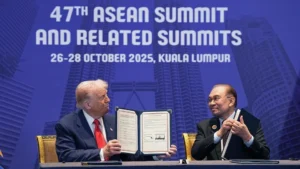Rio de Janeiro – As the 17th BRICS Summit convenes in Brazil this month, the world is watching a quiet revolution unfold. With BRICS+ now representing over 40% of global trade and population, and with trade volumes among members soaring past $4 trillion, the once-overlooked bloc is no longer a loose coalition of emerging economies—it is fast becoming the axis of a new global economic paradigm.
The summit marks the formal expansion of BRICS from five to eleven member states, with Indonesia, Ethiopia, Egypt, Iran, Saudi Arabia, and the UAE joining the original five. The addition of 10 partner countries, including Vietnam, Malaysia, and Uzbekistan, signals not just growth, but a strategic pivot—BRICS is no longer just about the Global South. It is about a multipolar future.
The Numbers Behind the Power Shift
According to a UNIDO policy report published in February 2025, total trade among BRICS nations has exploded from $572 billion in 2002 to over $4 trillion in 2021—a 700%+ increase. Much of this growth has occurred without any formal trade agreements, driven instead by deepening bilateral ties, parallel infrastructure, and a shared goal of economic sovereignty.
Intra-BRICS trade has grown faster than with external partners, reshaping global value chains and minimizing dependence on traditional Western trade networks. UNCTAD data confirms that South–South trade volume jumped from $2.3 trillion in 2007 to $5.6 trillion in 2023, underscoring a systemic rebalancing in global commerce.
This shift is not only economic—it’s geopolitical. As BRICS grows, the bloc becomes a challenge to the dollarized system and the institutions of Bretton Woods. It raises the question: what happens when the majority of the world’s population finds new pathways for trade, financing, and industrial growth—ones that exclude Washington and Brussels?
The “Counter-Globalization” of Investment Flows
BRICS is not only trading with itself—it is attracting massive inflows of capital. In 2023 alone, China ranked among the world’s top three FDI destinations, while Brazil and India each drew $130 billion. Total FDI to BRICS countries surged from $84 billion in 2001 to $355 billion in 2021, with the bloc’s share of global FDI doubling from 11% to 22%.
Countries like Indonesia, Vietnam, and the UAE are now top-tier FDI targets, leveraging membership or alignment with BRICS to secure infrastructure, green tech, and industrial relocation. Multinationals are not just investing—they are shifting production, transferring technology, and restructuring value chains outside the Atlantic core.
This shift in capital flow represents a slow-motion decoupling from Western financial hegemony. Though “BRICS Pay” and other dedollarization tools remain in development, the strategy is clear: build financial instruments and trading ecosystems that no longer rely on U.S. banks, U.S. courts, or U.S. strategic tolerance.
From the Margins to the Center of Global GDP
The bloc’s economic gravity has quietly overtaken the West. According to Carnegie Endowment, BRICS countries have expanded their share of global GDP (by PPP) from 21% in 2000 to nearly 35% in 2024—surpassing the G7, whose share has dropped to 30%. That gap continues to widen.
In 2018, BRICS overtook the G7 by PPP for the first time. Now, in 2025, that moment is no longer symbolic—it is structural. Global economic influence is no longer tied exclusively to the OECD countries. The periphery is now the center, and BRICS is the platform shaping this transition.
Tensions Within—and Outside—the Bloc
Yet, all is not harmonious inside BRICS. Fossil fuel producers like Russia and Iran remain invested in traditional energy exports, even as China, Brazil, and India push forward with green industrialization. The question for BRICS is no longer if it will lead, but what direction it will lead in—toward the energy politics of the 20th century, or the technological sovereignty of the 21st.
Outside the bloc, the U.S.–EU alliance is fraying. With Trump’s re-election, European leaders have declared Washington an “enemy of the European project.” In Gaza, the collapse of Western moral authority has alienated key Southern partners. The West no longer has the leverage it once did.
A Forum for a New Order
As the BRICS+ summit opens in Rio, expectations are high. The agenda includes proposals for new trade frameworks, investment mechanisms, and climate-linked industrial strategies. Whether these plans will be executed remains uncertain—but the momentum is undeniable.
This is no longer a question of whether BRICS can compete with Western-led systems. The real question is whether the West can adapt fast enough to avoid being bypassed entirely.
In the words of economist Larry Summers:
“There’s a growing sense that ours may not be the best fragment to be associated with.”
BRICS+ is no longer the future. It is the new present—and global power is being redefined in real time.











